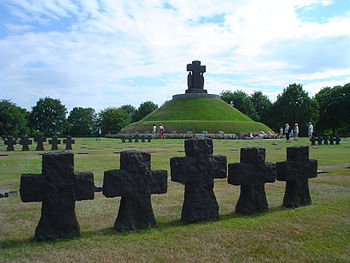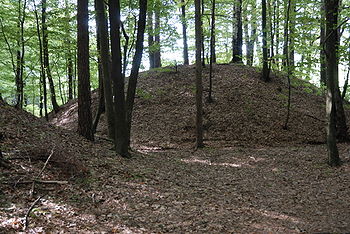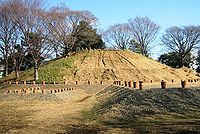- Tumulus
-
For other uses, see Tumulus (disambiguation).
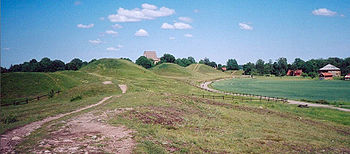 The Royal mounds of Gamla Uppsala in Sweden from the 5th and the 6th centuries. Originally, the site had 2000 to 3000 tumuli, but owing to quarrying and agriculture only 250 remain.
The Royal mounds of Gamla Uppsala in Sweden from the 5th and the 6th centuries. Originally, the site had 2000 to 3000 tumuli, but owing to quarrying and agriculture only 250 remain.
A tumulus (plural tumuli) is a mound of earth and stones raised over a grave or graves. Tumuli are also known as barrows, burial mounds, Hügelgrab or kurgans, and can be found throughout much of the world. A tumulus composed largely or entirely of stones is usually referred to as a cairn. A long barrow is a long tumulus, usually for numbers of burials.
The method of inhumation may involve a dolmen, a cist, a mortuary enclosure, a mortuary house or a chamber tomb. Examples of barrows include Duggleby Howe and Maeshowe.
The word tumulus is Latin for 'mound' or 'small hill', from the PIE root *teuh2- with extended zero grade *tum-, 'to bulge, swell' also found in tumor, thumb, thigh and thousand.[1]
Contents
Tumulus burial accounts
The funeral of Patroclus is described in book 23 of the Iliad. Patroclus is burned on a pyre, and his bones are collected into a golden urn in two layers of fat. The barrow is built on the location of the pyre. Achilles then sponsors funeral games, consisting of a chariot race, boxing, wrestling, running, a duel between two champions to the first blood, discus throwing, archery and spear throwing.
Beowulf is taken to Hronesness, where he burned on a funeral pyre. During cremation, the Geats lament the death of their lord, a widow's lament being mentioned in particular, singing dirges as they circumambulate the barrow. Afterwards, a mound is built on top of a hill, overlooking the sea, and filled with treasure. A band of twelve of the best warriors ride around the barrow, singing dirges in praise of their lord.
Parallels have also been drawn to the account of Attila's burial in Jordanes' Getica.[2] Jordanes tells that as Attila's body was lying in state, the best horsemen of the Huns circled it, as in circus games.
An Old Irish Life of Columcille reports that every funeral procession "halted at a mound called Eala, whereupon the corpse was laid, and the mourners marched thrice solemnly round the spot."
Types of barrows
Archaeologists often classify tumuli according to their location, form, and date of construction. See also mound and howe. Some British types are listed below:
- Bank barrow
- Bell barrow
- Bowl barrow
- D-shaped barrow, round barrow with a purposely flat edge at one side often defined by stone slabs
- Disc barrow
- Fancy barrow, generic term for any Bronze Age barrows more elaborate than a simple hemispherical shape.
- Long barrow
- Oval barrow, Neolithic long barrow consisting of an elliptical, rather than rectangular or trapezoidal mound
- Platform barrow, The least common of the recognised types of round barrow, consisting of a flat, wide circular mound that may be surrounded by a ditch. They occur widely across southern England with a marked concentration in East and West Sussex.
- Pond barrow, a barrow consisting of a shallow circular depression, surrounded by a bank running around the rim of the depression, from the Bronze age
- Ring barrow, a bank that encircles a number of burials
- Round barrow, a circular feature created by the Bronze Age peoples of Britain and also the later Romans, Vikings, and Saxons Divided into subclasses such as saucer and bell barrow—the Six Hills are a rare Roman example
- Saucer barrow, circular Bronze Age barrow that features a low, wide mound surrounded by a ditch that may have an external bank
- Square barrow, burial site, usually of Iron Age date, consisting of a small, square, ditched enclosure surrounding a central burial, which may also have been covered by a mound
Sites
Eastern Europe, Central Asia
Main article: KurganThe word kurgan is of Turkic origin borrowed from Russian language. In Ukraine and Russia, there are royal kurgans of Varangian chieftains, such as the Black Grave in Ukrainian Chernihiv (excavated in the 19th century), Oleg's Grave in Russian Staraya Ladoga, and vast, intricate Rurik's Hill near Russian Rurikovo gorodische. Other important kurgans are found in Ukraine and South Russia and are associated with much more ancient steppe peoples, notably the Scythians (e.g.,Chortomlyk, Pazyryk) and Proto-Indo-Europeans (e.g., Ipatovo) The steppe cultures found in Ukraine and South Russia naturally continue into Central Asia, in particular Kazakhstan.
Albania
Tumuli are one of the most prominent types of prehistoric monuments spread throughout north and south Albania. Some well-known tumuli are:
- Kamenica Tumulus
- Lofkënd Tumulus
- Pazhok Tumulus
Bosnia and Herzegovina
More than 50 burial mounds were found in Kupres. Man from Kupres- the skeleton found in one of the tumuli is believed to be more than 3000 years old and it is kept in Gorica museum in Livno. Glasinac has many tumuli. During the Bronze and Iron Age it was a place of strong Glasinac culture, who buried their dead in tumulus.
Bulgaria
 Memorial of the Battle of Varna dedicated to Władysław III of Poland dug into an ancient Thracian tumulus
Memorial of the Battle of Varna dedicated to Władysław III of Poland dug into an ancient Thracian tumulus
Hundreds of Thracian burial mounds are found throughout Bulgaria, including the Kazanlak and Sveshtari tombs, UNESCO World Heritage sites. Located near the ancient Thracian capital cities of Seuthopolis (of the Odrysian kingdom) and Daosdava or Helis (of the Getae), perhaps they represented royal burials. Other tombs contained offerings such as the Panagyurishte and Rogozen treasures.
Croatia
There are thousands of tumuli throughout all Croatia, built of stone (Croatian: gomila, gromila) in the carst areas (by the Adriatic Sea) or made of earth (Croatian: humak) in the inland plains and hills. The most of these prehistoric structures were built in the 2nd and 1st millennium BC, from the middle Bronze Age to the end of the Iron Age, by the Illyrians or their direct ancestors in the same place; the Liburnian inhumation of dead under tumuli was certainly inherited from the earlier times, as early as the Copper Age. Smaller tumuli were used as the burial mounds, while bigger (some up to 7 meters high with 60 meters long base) were the cenotaphs (empty tombs) and ritual places.[3]
Hungary
There are many tumuli in the Great Hungarian Plain, the highest is near the settlement of Békésszentandrás, in Békés county.[4] There are over 40.000 tumuli in the Great Hungarian Plain. Their Hungarian name is kunhalom ('Cumanian Barrow'). Their origin is diverse: tells, graves, border barrows, watcher barrows.[5]
Serbia
Main article: List of tumuli in Serbia- Mrčajevci, several prehistoric tumuli
- Bukovac, Illyrian tumuli and necropolis
- Five prehistoric tumuli in the Morava valley.
- Gromile, Serbian tumuli in Ravna Gora.[6]
Western and Central Europe
Austria
- Burgstallkogel (Sulm valley)
- Großmugl
- Niederhollabrunn (in Niederösterreich)
- Niederfellabrunn
- Oberhofen am Irrsee
- Obermalebern
- Unterzögersdorf
Belgium
- Two Tumuli of Ambresin (Liège)
- Tumulus of Avernas in Hannut (Liège) : height = 8 m ; circumference = 100 m
- Tumulus of the "champ de la Tombe" in Braives (Liège), 1st century CE Roman tomb.
- Tumulus of Court-Saint-Etienne (Walloon Brabant), around 3,000 BCE.
- Tumulus of Glimes in Incourt (Walloon Brabant), Gallo-Roman period : height = 11 m ; diameter = 50 m
- Tumulus of Hottomont in Ramillies (Walloon Brabant), tomb of Roman general Otto : height = 11.5 m ; diameter = 50 m
- Tumulus of Oleye (Liek) (Liège)[7]
- Tumulus of Pepin of Landen in Landen (Flemish Brabant)
- Tumuli of the Sonian Forest (Flemish Brabant), first millennium BCE.
- Three Tumuli of Grimde in Tienen (Flemish Brabant), 1st century BCE Gallo-Roman tombs.[8]
- Tumulus of Trou de Billemont in Antoing (Hainaut), 6th and 7th-century Merovingian tombs.
- Tumulus of Walhain (Walloon Brabant)
- Two Tumuli of Waremme (Liège)
- Tumuli of Wéris (Luxembourg), 3rd and 4th millennium BCE.
Britain
Main article: Anglo-Saxon burial mounds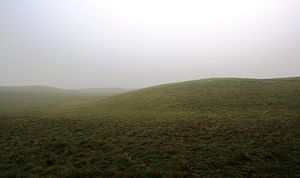 Part of the burial ground at Sutton Hoo, Suffolk
Part of the burial ground at Sutton Hoo, Suffolk
In Britain, barrows of a wide range of types were in widespread use for burying the dead from the late Neolithic until the end of the Bronze Age, 2900-800BC. Square barrows were occasionally used in the Iron Age (800BC-43AD) in the east of England. The traditional round barrow experienced a brief resurgence following the Anglo-Saxon conquests, with the introduction of northern Germanic burial practices from continental Europe. These later barrows were often built near older Bronze Age barrows. They included a few instances of ship burial. Barrow burial fell out of use during the 7th century as a result of the spread of Christianity. Early scholarly investigation of tumuli and theorising as to their origins was undertaken from the 17th century by antiquaries, notably John Aubrey, and William Stukeley. During the 19th century in England the excavation of tumuli was a popular pastime amongst the educated and wealthy upper classes, who became known as "barrow-diggers". This leisure activity played a key role in laying the foundations for the scientific study of the past in Britain but also resulted in untold damage to the sites. Notable British barrows include:-
- West Kennet Long Barrow - Neolithic long barrow in Wiltshire
- Wayland's Smithy - Neolithic long barrow and chamber tomb in Oxfordshire (historically Berkshire)
- Belas Knap - Neolithic long barrow in Gloucestershire
- Maeshowe - Neolithic chambered cairn and passage grave on Mainland, Orkney
- Duggleby Howe - Neolithic round barrow in the East Riding of Yorkshire
- Sutton Hoo - 7th-century East Anglian ship burial with exceptionally rich grave goods in Suffolk
- Devil's Humps - Bronze Age barrow group on Bow Hill in West Sussex
- Devil's Jumps - Bronze Age barrow group on the South Downs of West Sussex
Czech Republic
During the early Middle Ages, Slavic tribesmen inhabiting what is now the Czech Republic used to bury their dead under barrows. This practice has been widespread in southern and eastern Bohemia and some neighboring regions, like Upper Austria and Lusatia, which at that time have been also populated with Slavic people. However, there are no known Slavic barrows in central part of the country (around Prague), neither they are found in Moravia. This has led some of the archaeologists to speculations about at least three distinct waves of Slavic settlers, which have colonized Czech lands separately from each other, each wave bringing its customs with it (including burial rituals).
At places where barrows have been constructed, they are usually found in groups (10 to 100 together), often forming several clearly distinct lines going from the west to the east. Only a few of them have been studied scientifically so far; in them, both burials by fire (with burnt ashes) and unburned skeletons have been found, even on the same site. It seems that builders of the barrows have at some time switched from burials by fire to burying of unburned corpses; however, the reason for such change is unknown. The barrows date too far back in history (700 AD to 800 AD) to contain any Christian influences - it is almost certain that all people buried in them were pagans.
As Czech barrows usually served for burials of poor villagers, only a few objects are found in them except for cheap pottery. Only one Slavic barrow is known to have contained gold.
Most of the Czech burial barrows have been damaged or destroyed by intense agriculture in the densely populated region. Those that remain are usually in forests, especially at hilltops in remote places. Therefore, there is no general knowledge about burial barrows in the Czech population.
The best Slavic barrow sites can be found near to Vitín, a small village close to České Budějovice. There are two groups of barrows close to Vitín, each containing about 80 barrows ordered in lines. Some of the barrows are as much as 2 meters high.
There are also some prehistoric burial barrows in Czech Republic, built by unknown people. Unlike Slavic barrows, they can be found all across the country, though they are scarce. Distinguishing them from Slavic ones is not an easy task for the unskilled eye. Perhaps the most famous of them forms the top of the Žuráň hill near Slavkov u Brna; it is from here that Napoleon commanded his forces during the Battle of Austerlitz.
Germany
Hügelgrab or Hügel-Grab ("Barrow", "burial mound" or "tumulus") - sites in Germany
Name Place Region Bundesland Type Date Era Auleben(Auleben grave-hill field) Auleben Nordhausen Thuringia Grave-hill field ca. 1500 - 1200 BCE Bronze Age, Early Stone Age Benther Berg(Benther hill) Badenstedt Region Hannover Lower Saxony Hilly-grave ca. 1800 - 1100 BCE Nordic Old Bronze Age Pöckinger Gemeindegebiet(Pöcking local community area) Pöcking Munich area Bavaria grave-hill field ca. 750 - 500 BCE Hallstatt culture Kreuzlinger Forst/Mühltal Gauting Munich area Bavaria Hilly-grave ca. 2000 - 1500 BCE Bronze Age Germanengrab (Itzehoe)(Germans Grave (Itzehoe)) Itzehoe Kreis Steinburg Schleswig-Holstein Hilly-grave ca. 1500 - 1300 BCE Bronze Age Giesen (village) Giesen (village) Landkreis Hildesheim Lower Saxony Hilly-grave ca. 1600 - 1200 BCE Bronze Age Glauberg Glauburg Wetteraukreis Hesse Kings graves 5th century BCE Early Celtic Age Grabhügelfeld von Bonstorf(Bonstorf Barrows) Bonstorf Landkreis Celle Lower Saxony grave-hill field ca. 1500 - 1200 BCE Bronze Age, Early Stone Age Lahnberge Marburg Landkreis Marburg-Biedenkopf Hesse >200 Hilly-graves ca. 1600 - 5th century BCE Middle Bronze Age (Hügelgräber Culture), Late Bronze Age (Urnfeld Culture), Iron Age (Hallstatt Culture) Hohmichele Hundersingen Landkreis Sigmaringen Baden-Württemberg Kings graves ca. 600 - 450 BCE Hallstatt culture Grave-hill of Hochdorf Hochdorf an der Enz Landkreis Ludwigsburg Baden-Württemberg Hilly-grave 5th Century BCE Hallstatt culture Grabauer Gräberfeld(Grave fields) Grabau (Stormarn) Kreis Stormarn Schleswig-Holstein 9 grave-hills 6500 - 5500 BCE Young Stone Age Beckdorf Beckdorf Landkreis Stade Lower Saxony Hilly-grave Heidelberg Wiera Schwalm-Eder-Kreis Hesse Hill-grave Bronze Age Lehbühl Schlaitdorf Landkreis Esslingen Baden-Württemberg Hill-grave ca. 600 - 400 BCE Hallstatt culture Willhofer Berg (Wilhof mountain) Willhof Landkreis Schwandorf Bavaria Hilly-grave ca. 1516 BCE Middle Bronze Age, early La Tene Age Mellingstedt Lemsahl-Mellingstedt Wandsbek Hamburg Hilly-grave Bronze Age Daxberg Daxberg (Mömbris) Landkreis Aschaffenburg Bavaria Hilly-grave field ca. 2000 - 800 BCE Iron Age Daxberg Daxberg (Erkheim) Landkreis Unterallgäu Bavaria Hilly-grave field 8th century BCE Iron Age Höltinghausen Höltinghausen Landkreis Cloppenburg Lower Saxony Hilly-grave field Hohenfelde Hohenfelde (Mecklenburg) Mecklenburgische Seenplatte Mecklenburg-Vorpommern 7 Hilly-graves ca. 1700 BCE Bronze Age Plankenheide Nettetal Kreis Viersen North Rhine-Westphalia Hill-grave Kranzberger Forst Kranzberg Landkreis Freising Bavaria 19 Hilly-graves Bronze Age Neu Quitzenow Neu Quitzenow Rostock Mecklenburg-Vorpommern 2 Hilly-graves ca. 1800 - 600 BCE Maaschwitz Maaschwitz Muldentalkreis Saxony Hilly-graves Königsgrab von Seddin Seddin Landkreis Prignitz Brandenburg Kings graves 8th century BCE Bronze Age Pestruper Gräberfeld (Pestrup Grave fields) Wildeshausen Landkreis Oldenburg Lower Saxony ~ 500 grave-hills ca. 900 - 200 BCE Bronze Age Plaggenschale Plaggenschale Landkreis Osnabrück Lower Saxony Mansenberge Groß Berßen Landkreis Emsland Lower Saxony Great stone grave 2000 BCE Megalith Culture Magdalenenberg Villingen Schwarzwald-Baar-Kreis Baden-Württemberg Kings grave ca. 616 BCE Hallstatt culture Tumulus von Nennig Nennig Landkreis Merzig-Wadern Saarland Grave-hill Bronze Age Wagengrab von Bell (Wagon grave of Bell) Bell (Hunsrück) Rhein-Hunsrück-Kreis Rhineland-Palatinate Wagon-grave 500 BCE Hallstatt culture Winckelbarg Landkreis Stade Lower Saxony Naturschutzgebiet Schweinert(Schweinert Nature reserve) Falkenberg Landkreis Elbe-Elster Brandenburg The Great Hill-Grave Field of Middle Europe (642 Hills) ca. 1000 BCE Breitenfeld Neuhausen ob Eck Landkreis Tuttlingen Baden-Württemberg 21 grave-hills ca. 700 BCE - 450 CE Hallstatt culture Ireland
A tumulus can be found close to the Grianán of Aileach in County Donegal. It has been suggested by historians such as George Petrie, who surveyed the site in the early 19th century, that the tumulus may predate the ringfort of Aileach by many centuries possibly to the neolithic age. Surrounding stones were laid horizontally, and converged towards the centre. the mound had been excavated in Petrie’s time, but nothing explaining its meaning was discovered. It was subsequently destroyed, but its former position is marked by a heap of broken stones. Similar mounds can be found at The Hill of Tara and there are several prominent tumuli at Brú na Bóinne in County Meath.
Italy
Some big tumulus tombs can be found especially in the Etruscan culture. Smaller barrows are dated to the Villanova period (9th - 8th century BC) but the biggest were used in the following centuries (from the 7th century afterwards) by the Etruscan aristocracy.
The Etruscan tumuli were normally family tombs that were used for many generation of the same noble family, and the deceased were buried with many precious objects that had to be the "grave goods" or the furnishings for these "houses" in the Afterlife. Many tombs also hold paintings, that in many cases represent the funeral or scenes of real life. The most important graveyards (necropolises) with tumulus tombs are Veio, Cerveteri, Vetulonia, Populonia. Many isolated big barrows can be found in the whole Etruscan territory (mostly in Central Italy).
Portugal
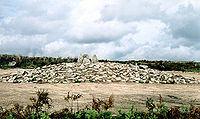 Tumulus at Outeiro de Gregos, Baião, Portugal (V or IV millennium BC)
Tumulus at Outeiro de Gregos, Baião, Portugal (V or IV millennium BC)
One of the most dense manifestations of the megalithic phenomenon in Europe occurred in Portugal. In the north of Portugal there are more than 1000 late prehistoric barrows. They generally occur in clusters, forming a necropolis. The method of inhumation usually involves a dolmen. The tumuli, dated from c. 4450 to 1900 BC, are up to 3 meters high, with diameters from 6 to 30 meters. Most of them are mounds of earth and stones but the more recent ones are composed largely or entirely of stones (cairns). In Portugal, barrows are called mamoas, from the Latin mammulas, given to them by the Romans because of their shape, similar to the breast of a woman.
Burial mounds were in use until the 11th century in Scandinavia and figure heavily into Norse paganism. In their undamaged state they appear as small, man-made hillocks, though many examples have been damaged by ploughing or deliberately damaged so that little visible evidence remains.
By burning the deceased, it was believed that the person was transferred to Valhalla by the consuming force of the fire. The fire could reach temperatures of 1500 °C. The remains were covered with cobblestones and then a layer of gravel and sand and finally a thin layer of turf. As the old Scandinavians worshiped their ancestors, the mounds were also places of worship. In Norse mythology, the draugr was an undead creature that haunted burial mounds
Thus he (Odin) established by law that all dead men should be burned, and their belongings laid with them on the pile, and the ashes be cast into the sea or buried in the earth. Thus, said he, every one will come to Valhalla with the riches he had with him upon the pile, and he would also enjoy whatever he himself buried in the earth. For men of consequence a mound should be raised to their memory, and for all other warriors distinguished for manhood, a standing stone. This custom remained long after Odin's time. [...] It was their faith that the higher the smoke arose in the air, the higher he would be raised whose pile it was, and the richer he would be, the more property that was consumed with him
Sweden
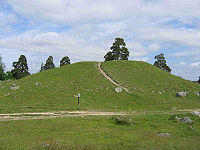 King Björn's barrow in Håga, Sweden.
King Björn's barrow in Håga, Sweden.
- Anundshög, located just outside the City of Västerås, is Sweden's largest burial mound.
- Gravhög Gårdstånga, situated in Eslöv Municipality, Skåne County, is the site of a Bronze Age burial mound, (Swedish: Gravhög).
- Hågahögen, King Björn's barrow in Håga (Old Norse word: haugr) near Uppsala has a very strong connection with Björn at Haugi.
- Kungshögar, an archaeological site on the Lake Mälaren island of Adelsö in Ekerö Municipality, contains five large burial mounds .
- Skalunda hög in Västergötland, the site of Skalunda Barrow, an historic burial mound.
Norway
- Borrehaugene (Borre mound cemetery) forms part of the Borre National Park in Horten, Vestfold. The park covers 45 acres (180,000 m2) and its collection of burial mounds includes, seven large mounds and one 25 small cairns.
- Gokstadhaugen a burial mound in Sandefjord, Vestfold, revealed a ship burial containing the Gokstad ship, a Viking era ship dated back to 9th century. The ship is the largest in the Viking Ship Museum in Bygdøy, Oslo.
- Båthaugen, a boat burial mound found at Rolvsøy in Tune, Østfold, contained the Tune ship, a Viking era ship of the "karv" type The ship was built around AD 900 and is made of clinkered oak planks.
- Oseberghaugen, the Oseberg burial mound at Oseberg near Tønsberg in Vestfold county, contained the Oseberg ship, a well-preserved Viking era ship dating from around AD 800.
- Storhaug (Great Mound) ship's burial mound Avaldsnes on Karmøy in Rogaland County, Norway contained a ship made of oak.
- Grønhaug (Green Mound), a ship burial at Avaldsnes, contained an approximately 15-metre (49 ft) long boat with remains of a man’s grave from the 10th century.
- Flagghaugen (Flag Hill Mound) at Avaldsnes, one of Norway’s richest grave dating from the pre-Viking Period, contained a neck ring of 600 grams (19 ozt) of pure gold, weapons, bandoleer mountings and various tubs of silver and bronze.
- Raknehaugen, estimated to date to around 550 AD, is located in the traditional district of Romerike. It is largest tumulus in Northern Europe.[9]
- Karnilshaugen, in Gloppen in the county of Sogn og Fjordane, is the site of Karnils tumulus burial mound
Denmark
- Yding Skovhøj in Horsens municipality, Jutland is one of Denmark's Bronze Age burial mounds built on the top of the hill.
- Klekkende Høj is a megalithic tomb on the island of Møn. It takes its name near the village of Klekkende.
- Lindholm Høje is a major Viking burial site and former settlement situated to the north of and overlooking the city of Aalborg.
- Grønjægers Høj, meaning the mound of Green Hunter, is located near Fanefjord Church on the Danish island of Møn.
Αegean and Near East
India
The Ahom kingdom in medieval Assam built octagonal tumuli called Maidams for their kings and high officials. The kings were buried in a hillock at Charaideo in Sibsagar district of Assam, whereas other Maidams are found scattered more widely.
Balochistan
The damb was a type of mound, or small stone structure, found in Balochistan, including the coastal areas of Makran.
Greece
Main article: VerginaSome of the world's most prominent Tumuli, the Macedonian tombs and a cist-grave at Vergina include the tomb of Philip II (359–336 BC), father of Alexander the Great (336–323 BC), as well as the tomb of Alexander IV (323–309 BC), son of Alexander the Great. Also numerous Mycenaean Greek Tombs are in all essence Tumuli, notably Agamemnon's site in Mycenae, and other sites in Tyrins, near Olympia and Pylos, and mostly in the Peloponnese peninsula near Mycenaean sites and bronze age settlements. Moreover, in central Greece there are numerous Tumuli, some excavated, others not. A notable one is in Marathon, serving as a burial for the ones who fell during battle.
Anatolia
On the Anatolian peninsula, there are several sites where one can find the biggest specimens of these artificial mounds throughout the world. Three of these sites are especially important. Bin Tepeler (and other Lydian mounds of the Aegean inland), Phrygian mounds in Gordium (Central Anatolia), and the famous Commagene tumulus on the Mount Nemrut (Southeastern Anatolia).
This is the most important of the enumerated sites with the number of specimens it has and with the dimensions of certain among them. It is in the Aegean inland of Turkey. The site is called "Bin Tepeler" (a thousand mounds in Turkish) and it is in the northwest of Salihli district of Manisa province. The site is very close to the southern shoreline of Lake Marmara (Lake Gyges or Gygaea). Bin Tepeler is a Lydian necropolis that dates back to 7th and 6th centuries BC. These mounds are called, "the pyramids of Anatolia," as a giant specimen among them is 355 meters in diameter, 1115 meters in perimeter and 69 meters high. According to Herodotus, this giant tumulus belongs to the famous Lydian King Alyattes II who ruled between 619–560 BC. There is also another mound belonging to King Gyges. The Gyges mound was excavated but the burial chamber hasn't been found yet. In this site, there are 75 tumuli dating back to Lydian period that belong to the nobility. A large number of smaller artificial mounds can also be observed in the site. There are other Lydian tumuli sites around Eşme district of Uşak province. Certain mounds in these sites had been plundered by raiders in the late 1960s, and the Lydian treasures found in their burial chambers were smuggled to the United States, which later returned them to Turkish authorities after negotiations. These artifacts are now exhibited in the Archaeological Museum of Uşak.
Gordium (Gordion) was the capital of the ancient kingdom of Phrygia. Its ruins are in the immediate vicinity of Polatlı, near the Turkish capital Ankara. At this site, approximately 80-90 tumuli date back to the Phrygian, Persian and Hellenistic periods. Around 35 tumuli have been excavated so far, ranging in date from the 8th century BC to the 3rd or 2nd century BC. The biggest tumulus at the site is believed to have covered the burial of the famous Phrygian King Midas or that of his father. This mound, called Tumulus MM (for "Midas Mound"), was excavated in 1957 by a team from the University of Pennsylvania Museum. Among the many fine bronze artifacts recovered from the wooden burial chamber were 170 bronze vessels, including numerous "omphalos bowls," and more than 180 bronze "Phrygian fibulae" (ancient safety pins). The wooden furniture found in the tomb is especially noteworthy, as wood seldom survives from archaeological contexts: the collection included nine tables, one of them elaborately carved and inlaid, and two ceremonial serving stands inlaid with religious symbols and geometric patterns. Important bronze and wooden artifacts were also found in other tumulus burials at the site.
The Mount Nemrut is 86 km in the east of Adıyaman province of Turkey. It is very close to Kahta district of the same province. The mountain has, at its peak, 3050 meters of height above the sea level. A tumulus that dates to the 1st century BC is at the peak of the mountain. This artificial mound has 150 meters of diameter and a height of 50 meters, which was originally 55 meters. It belongs to the Commagene King Antiochus I Theos of Commagene who ruled between 69–40 BC. This tumulus is made of broken stone pieces, which renders excavation attempts almost impossible. The tumulus is surrounded by ceremonial terraces in the east, west, and north. The east and west terraces have tremendous statues (reaching 8 to 10 meters of height) and bas reliefs of gods and goddesses from the Commagene pantheon where divine figures used to embody the Persian and Roman perceptions together.
Levant
A tumulus forms the center of the ancient megalithic structure of Rujm el-Hiri in the Golan Heights. Rujm in Arabic can mean tumulus, cairn or stone heap. Near the western city limits of modern Jerusalem, 19 tumuli have been documented (Amiran, 1958). Though first noticed in the 1870s by early surveyors, the first one to be formally documented was Tumulus #2 in 1923 by William Foxwell Albright, and the most recent one (Tumulus #4) was excavated by Gabriel Barkay in 1983. The association of these tumuli with the Judean kings who ruled Jerusalem does not substantiate Biblical history since it is mere speculation. No inscriptions naming any specific Judean king have been excavated from a tumulus.
- More than half of these ancient Israeli structures have now been threatened or obliterated by modern construction projects, including Tumulus #4, which was excavated hastily in a salvage operation. The most noteworthy finds from this dig were two LMLK seal impressions and two other handles with associated Concentric Circle incisions, all of which suggests this tumulus belonged to either King Hezekiah (Barkay, 2003, p. 68) or his son Manasseh (Grena, 2004, p. 326).
- When comparing the number of these tumuli to the total number of Israelite kings (northern and southern), note that Saul never ruled in Jerusalem, and Athaliah was never crowned. She took the throne by force (2Kings 11:1-3), and would certainly not have been honored with a tumulus ceremony following her brutal assassination.
- The northern kings did not reign over the southern kingdom, and they would certainly not have been honored with a tumulus ceremony in Jerusalem; if any ceremonies were held for them, they would have transpired in the north (near Bethel, Tirzah, or Samaria).
East Asia
China
Main article: Chinese pyramidsJapan
In Japan, powerful leaders built tumuli known as kofun. The Kofun period of Japanese history takes its name from these burial mounds. The largest is over 400 meters in length. In addition to other shapes, kofun include a keyhole shape.
Korea
The first burial mounds in Korea were dolmens, which contained material from cultures of the first millennium CE, such as bronze-ware, pottery, and other symbols of society elite.
The most famous tumulii in Korea, dating around 300 AD, are those left behind by the Korean Baekje, Goguryeo(Kogyuro/Koguryo), Silla, and Gaya states and are clustered around ancient capital cities in modern-day Pyongyang, Seoul, Ji'an, and Gyeongju. The Goguryeo tombs, shaped like pyramids, are famous for the well-preserved wall murals like the ones at Anak Tomb No.3, which depict the culture and artistry of the people. The base of the tomb of King Gwanggaeto is 85 meters on each side, half of the size of the Great Pyramids.[1] Goguryeo Silla tombs are most noted for the fabulous offerings that have been excavated such as delicate golden crowns and glassware and beads that probably made their way to Korea via the Silk Road.
Many indigenous Korean artifacts and culture were transmitted to the tomb builders of early Japan, such as horsetrappings, bronze mirrors, paintings and iron-ware.
-
- see also Cheonmachong, the Heavenly Horse Tomb
North America
Canada
Human settlement in L'anse Amour dates back at least 7,500 years as evidenced by the burial mound of a Maritime Archaic boy. His body was wrapped in a shroud of bark or hide and placed face down with his head pointed to the west. The site was first excavated in the 1970s.
The Augustine Mound is an important Mi'kmaq burial site in New Brunswick.
In Southwestern British Columbia, several types of burial mounds are known from the Salishan region (Hill-Tout 1895).
United States
Main articles: Mound builder (people) and List of burial mounds in the United StatesMound building was a central feature of the public architecture of many Native American cultures from Chile to Minnesota. Thousands of mounds in the USA have been destroyed as a result of farming, pot-hunting, amateur and professional archaeology, road-building and construction. Surviving mounds are still found in river valleys, especially along the Mississippi, Tennessee and Ohio Rivers, and as far west as Spiro Mounds in Oklahoma.[12]
Mounds were used for burial, to support residential and religious structures, to represent a shared cosmology, and to unite and demarcate community. Common forms include conical mounds, ridge-top mounds, platform mounds, and animal effigy mounds, but there are many variations. Mound building in the USA is believed to date back to at least 3400 BC in the Southeast (see Watson Brake). The Adena and the Mississippian cultures are principally known for their mounds, as is the Hopewell tradition. The largest mound site north of Mexico is Cahokia, a vast World Heritage Site located just east of St. Louis, Missouri.
See also
Notes
- ^ Calvert Watkins, American Heritage Dictionary of Indo-European Roots, 2000, p. 92.
- ^ Frederick Klaeber, Attila's and Beowulf's funeral, PMLA (1927); Martin Puhvel, The Ride around Beowulf's Barrow, Folklore (1983).
- ^ (Croatian) Goran Majetić (July 9, 2008). "Tumulusi u Hrvatskoj - veličanstvene prapovijesne "piramide"". =udruga-kameleon.ht. http://www.udruga-kameleon.hr/tekst/1134/. Retrieved 8 October 2010.
- ^ "Picture of "Gödény-halom"". http://www.bekesszentandras.hu/turizmus_seta.htm#.[dead link]
- ^ "Kiss Csaba: A kunhalmok védelme és meghmentésük lehetőségei. A Puszta 1999/1 pp 240-287". http://www.nimfea.hu/kiadvanyaink/puszta/kisscs%20-%20kunhalom%20-%2099.pdf.
- ^ Prof. dr Ljubisa Folic. "Crucified Heritage". kosovo.net accessdate=8 October 2010. http://www.kosovo.net/crucified/cr_heritage.html.
- ^ List of Dutch exonyms for places in Belgium
- ^ Location Tumuli of Grimde Tienen
- ^ Raknehaugen
- ^ "?". http://www.dkconline.dk/wincgi/dkc.exe?Function=GetLokalitet&Systemnr=41576.[dead link]
- ^ Inge Adriansen. Nationale symboler i det Danske Rige, 1830-2000, Vol. 2, 2003, p. 123. ISBN 978-87-7289-794-3.
- ^ http://en.wikipedia.org/wiki/Spiro_Mounds
References
- Knight, Peter, 1996, Ancient Stones of Dorset.
- Knight, Peter, 2011, West Kennet Long Barrow: Landscape, Shamans and the Cosmos. Stone Seeker.
- Albright, William F. (1923). "Interesting finds in tumuli near Jerusalem". Bulletin of the American Schools of Oriental Research (The American Schools of Oriental Research) 10 (April): 1–3. doi:10.2307/1354763. JSTOR 1354763.
- Amiran, Ruth (1958). "The tumuli west of Jerusalem, Survey and Excavations, 1953". Israel Exploration Journal 8 (4): 205–27.
- Barkay, Gabriel (2003). "Mounds of mystery: where the kings of Judah were lamented". Biblical Archaeology Review 29 (3): 32–9, 66, 68.
- Grena, G. M. (2004). LMLK--A Mystery Belonging to the King vol. 1. Redondo Beach, California: 4000 Years of Writing History. ISBN 0-9748786-0-X.
- Grinsell, L.V., 1936, The Ancient Burial-mounds of England. London: Methuen.
- Nelson, Sarah Milledge (1993). The Archaeology of Korea. New York: Cambridge University Press.: Cambridge University Press. ISBN 0-521-40783-4.
Hill-Tout C. 1895. Late Prehistoric Man in British Columbia. Transactions of the Royal Society of Canada, Second Series 1(2):103-122.
External links
Categories:- Barrows
- European archaeology
- Archaeology of the Americas
- Asian archaeology
- Mound builders (people)
- Burial monuments and structures
- Archaeology of death
- Latin words and phrases
Wikimedia Foundation. 2010.

